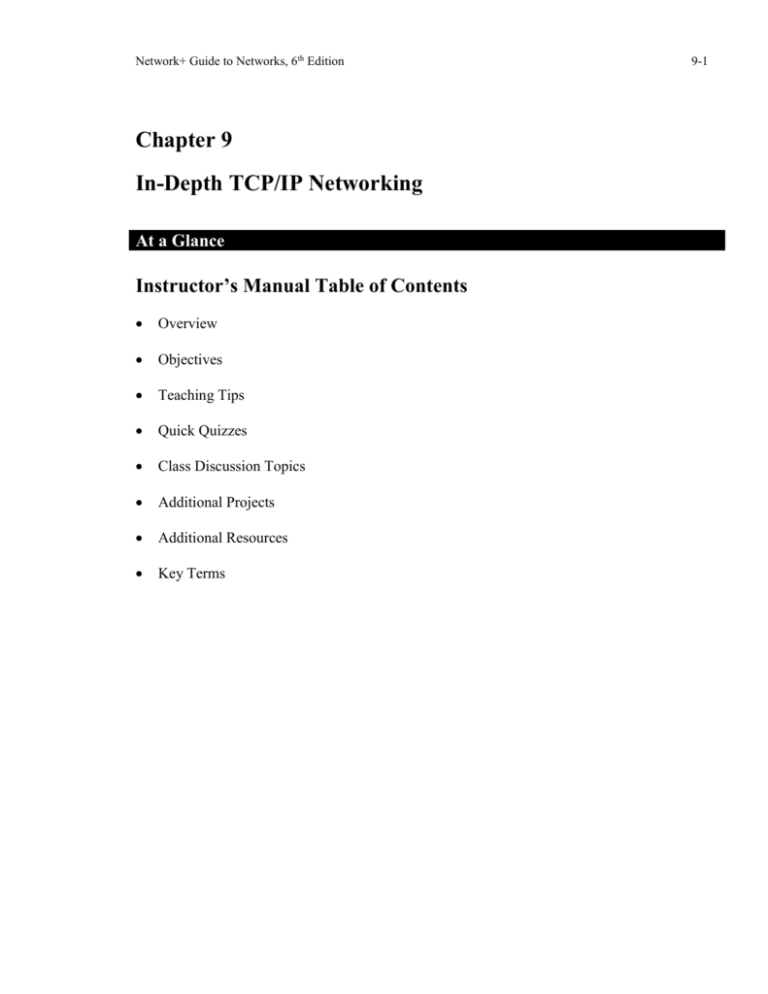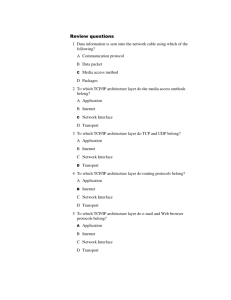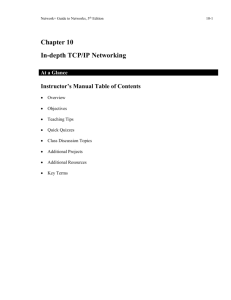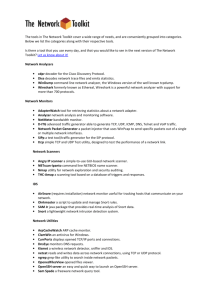Instructors Notes
advertisement

Network+ Guide to Networks, 6th Edition Chapter 9 In-Depth TCP/IP Networking At a Glance Instructor’s Manual Table of Contents Overview Objectives Teaching Tips Quick Quizzes Class Discussion Topics Additional Projects Additional Resources Key Terms 9-1 Network+ Guide to Networks, 6th Edition 9-2 Lecture Notes Overview In Chapter 4, students learned about core protocols and subprotocols in the TCP/IP protocol suite, addressing schemes, and host and domain naming. Students also learned that TCP/IP is a complex and highly customizable protocol suite. This chapter builds on these basic concepts, examining how TCP/IP-based networks are designed and analyzed. It also describes the services and applications that TCP/IP-based networks commonly support. Chapter Objectives After reading this chapter and completing the exercises, the student will be able to: Describe methods of network design unique to TCP/IP networks, including subnetting, CIDR, and address translation Explain the differences between public and private TCP/IP networks Describe protocols used between mail clients and mail servers, including SMTP, POP3, and IMAP4 Employ multiple TCP/IP utilities for network discovery and troubleshooting Teaching Tips Designing TCP/IP-Based Networks 1. Describe how most modern networks rely on the TCP/IP protocol suite. 2. Review TCP/IP fundamentals. 3. Note the two versions of IP. a. Explain why this discussion on IP addressing focuses on IPv4. 4. Review these IPv4 address expressions: a. Binary and dotted decimal 5. Remind students that many networks assign IP addresses and host names dynamically, using DHCP, rather than statically. 6. Review network classes. a. Emphasize that a node’s network class provides information about the segment or network to which the node belongs. Subnetting 1. Define the term subnetting. Network+ Guide to Networks, 6th Edition 9-3 2. Discuss how networks are commonly subnetted. a. Geographic locations b. Departmental boundaries c. Technology types 3. Discuss three reasons why a network administrator might separate traffic. 4. Review IPv4 addressing conventions on a network that does not use subnetting. 5. Introduce and explain classful addressing in IPv4. 6. Remind students that all IPv4 addresses consist of network and host information. 7. Explain where the network information portion of an IPv4 address (the network ID) is located in classful addressing: a. First 8 bits in a Class A address b. First 16 bits in a Class B address c. First 24 bits in a Class C address 8. Explain where the host information portion of an IPv4 address is located in classful addressing: a. Last 24 bits for a Class A address b. Last 16 bits in a Class B address c. Last 8 bits in a Class C address 9. Use Figure 9-1 to illustrate examples of IPv4 addresses separated into network and host information according to the classful addressing convention. 10. Introduce and describe IPv4 subnet masks. 11. Use Table 9-1 to illustrate how each network class is associated with a default subnet mask. a. Remind students that an octet composed of all 1s in binary notation equals 255 in decimal notation and an octet composed of all 0s in binary notation equals 0 in decimal notation. 12. Define and explain the concept of ANDing. a. Explain how to calculate a host’s network ID given its IPv4 address and subnet mask. b. Use Table 9-2 to illustrate ANDing. c. Use Figure 9-3 to illustrate and example of calculating a host’s network ID. Network+ Guide to Networks, 6th Edition Teaching Tip 9-4 Point out that several online sites and operating systems provide calculators that calculate AND operations. Provide a class demonstration of the Windows operating system calculator by navigating to the Accessories area containing the calculator. Change the calculator view to scientific if necessary. Select “bin” for input and practice ANDing two binary numbers of various numeric contents and lengths. 13. Define and explain the concept of reserved addresses. a. Describe why the network ID is considered a reserved address. b. Describe why the broadcast address is considered a reserved address. c. Explain why only the numbers 1 through 254 can be used for host information in an IPv4 address. 14. Introduce and explain IPv4 subnetting techniques. a. Note that subnetting breaks the rules of classful IPv4 addressing. b. Describe how some bits in an IP address that represent host information in classful addressing are changed to represent network information instead. c. Emphasize the consequence of subnetting in terms of the number of useable host addresses available per subnet. d. Use Table 9-5 to illustrate the numbers of subnets and hosts that can be created by subnetting a Class B network. e. Use Table 9-5 to illustrate the numbers of subnets and hosts that can be created by subnetting a Class C network. 15. Introduce the topic of calculating IPv4 subnets. a. Present and explain the formula for determining how to modify a default subnet mask. b. Walk through an example that utilizes a leased Class C network with network ID of 199.34.89.0 and then divides it into six subnets. c. Use Table 9-6 to illustrate a listing of the network ID, broadcast address, and usable host addresses for each of the six subnets in the example Class C network. d. Point out that the extended network prefix for each subnet is based on which of the additional (borrowed) network information bits are set to equal 1. e. Point out that Class A, Class B, and Class C networks can all be subnetted; however, each class reserves a different number of bits for network information and each class has a different number of host information bits that can be used for subnet information. f. Explain how subnetting on a LAN affects LAN devices. g. Use Figure 9-4 to illustrate and explain a situation in which a LAN running IPv4 has been granted the Class C range of addresses that begin with 199.34.89. Network+ Guide to Networks, 6th Edition Teaching Tip 9-5 Point out that several Web sites provide excellent tools to assist network administrators in calculating subnet information. Provide a classroom demonstration by navigating to http://www.subnetmask.info to illustrate one such site. CIDR (Classless Interdomain Routing) 1. Introduce and explain CIDR (Classless Interdomain Routing). 2. Mention that CIDR is sometimes called classless routing or supernetting. 3. Walk through an example of CIDR in which a subnet boundary moves to the left. a. Emphasize that moving the subnet boundary to the left allows an administrator to use more bits for host information and, therefore, generate more usable IP addresses on the network. b. Mention that a subnet created by moving the subnet boundary to the left is known as a supernet. 4. Use Figure 9-5 to contrast examples of a Class C supernet mask with a subnet mask. a. In Figure 9-5, point out that 27 bits are used for network information in the subnet mask, whereas in the superset mask, only 22 bits are used for network information. 5. Walk through an example where an organization has leased the Class C range of IPv4 addresses that shares the network ID 199.34.89.0 and, because of growth in the company, the network administrator needs to increase the number of host addresses this network allows by default. a. Use Figure 9-6 to illustrate the process of calculating a host’s network ID on a supernetted network. 6. Describe CIDR notation (or slash notation). 7. Define and describe a CIDR block. 8. Wrap up this topic by emphasizing that to take advantage of classless routing, a network’s routers must be able to interpret IP addresses that do not adhere to conventional network class parameters. a. Routers that rely on older routing protocols, such as RIP, are not capable of interpreting classless IP addresses. Teaching Tip Point out that CIDR is pronounced cider. Network+ Guide to Networks, 6th Edition 9-6 Subnetting in IPv6 1. Explain that IPv6 addresses are classless. 2. Explain that an IPv6 address divides into a 64-bit subnet prefix and 64-bit interface identifier. 3. Use Figure 9-7 to show the prefix and interface portions of an IPv6 address. 4. Remind students that they may see IPv6 addresses containing a slash, such as 2608:FE10:1:A::/64, but that the left-most 64 bits of any IPv6 address are the subnet portion of the address. 5. Explain how subnet prefixes may be assigned from a national NSP down to a local ISP level, using Figure 9-8. Internet Gateways 1. Define and explain a gateway. 2. Define the term default gateway. 3. Explain characteristics of default gateways. 4. Use Figure 9-9 to illustrate the use of default gateways. 5. Define and describe the advantages of a default router. 6. Describe two default gateway connections. 7. Note that routers used as gateways must maintain routing tables. 8. Describe the gateways that make up the Internet. 9. Define a core gateway. Teaching Tip Student may read more about “Using Internet Gateway Device Discovery and Control” at http://windowshelp.microsoft.com/Windows/en-US/help/670718ec7d51-49ed-87f1-b8a98ced11a41033.mspx Address Translation 1. Define the term public network and provide examples. 2. Define the term private network and provide examples. Network+ Guide to Networks, 6th Edition 9-7 3. Explain how hiding IP addresses on private networks allows network managers more flexibility in assigning addresses. 4. Define the term NAT (Network Address Translation). 5. Describe reasons for using address translation. 6. Define and describe SNAT (Static Network Address Translation). 7. Use Figure 9-10 to illustrate SNAT. 8. Define and describe DNAT (Dynamic Network Address Translation). 9. Mention that DNAT is also called IP masquerading. 10. Define and describe PAT (Port Address Translation). 11. Use Figure 9-11 to illustrate an example of PAT usage. 12. Explain how the gateway might instead operate on a network host. 13. Describe how in Windows operating systems, ICS (Internet Connection Sharing) can be used to translate network addresses and allow clients to share an Internet connection. Teaching Tip Student may find a “Description of Internet Connection Sharing” at http://support.microsoft.com/kb/234815 Quick Quiz 1 1. True or False: DHCP may be used to assign IP addresses and host names dynamically. Answer: True 2. A node’s network ____ provides information about the segment or network to which the node belongs. a. frame b. location c. class d. routing table Answer: C 3. Subnetting separates a network into multiple logically defined segments, or ____________________. Answer: subnets Network+ Guide to Networks, 6th Edition 9-8 4. True or False: Subnet masks are only used in IPv4 classful addressing. Answer: False 5. A broadcast address is known as a(n) ____ address for a network or segment. a. reserved b. default c. open d. informative Answer: A 6. True or False: In CIDR, conventional network class distinctions exist. Answer: False TCP/IP Mail Services 1. Explain why it is important to understand how mail services work. 2. Point out that all Internet mail services rely on the same principles of mail delivery, storage, and pickup, though they may use different types of software to accomplish these functions. 3. Explain the function of mail servers. 4. Explain the function of mail clients. 5. Emphasize that e-mail servers and clients communicate through special TCP/IP Application layer protocols. SMTP (Simple Mail Transfer Protocol) 1. Define and describe SMTP. 2. Point out that SMTP transports mail and holds it in a queue. 3. Mention that in Internet e-mail transmission, higher-level mail protocols such as POP and IMAP may attempt to figure out what went wrong with an undeliverable message. 4. Describe how to configure a client to use SMPT. Teaching Tip Student may find more information on SMTP at http://www.cisco.com/en/US/docs/ios/sw_upgrades/interlink/r2_0/user/ugsmtp.html MIME (Multipurpose Internet Mail Extensions) 1. Explain the drawbacks of SMTP. Network+ Guide to Networks, 6th Edition 9-9 2. Define and describe MIME as a solution to the ASCII character limit of 1,000. a. Note that MIME is a standard for encoding and interpreting binary files, images, video, and non-ASCII character sets within an e-mail message. b. Point out that MIME identifies each element of a mail message according to content type. c. Mention that MIME encodes different content types so that SMTP is fooled into thinking it is transporting an ASCII message stream. 3. Emphasize that MIME does not replace SMTP, but works in conjunction with it. 4. Note that most modern e-mail clients and servers support MIME. POP (Post Office Protocol) 1. Define and describe POP. 2. Note the most current version. 3. Describe how POP3 mail is stored and delivered. 4. Describe the advantages of using POP3. 5. Emphasize that mail is deleted from the server after it is downloaded. a. Explain why this can be troublesome for mobile users. IMAP (Internet Message Access Protocol) 1. Point out that IMAP is a mail retrieval protocol that was developed as a more sophisticated alternative to POP3. 2. Describe the advantages of IMAP. 3. Describe the features of IMAP. 4. Describe the disadvantages of IMAP. Teaching Tip Students may find more information on how e-mail works at http://communication.howstuffworks.com/email.htm Additional TCP/IP Utilities 1. Note that there are many points of failure in a TCP transmission. Network+ Guide to Networks, 6th Edition 9-10 2. Explain how TCP/IP attempts to help an administrator track down most TCP/IP-related problems without using expensive software or hardware to analyze network traffic. 3. Emphasize why students should be familiar with TCP/IP diagnostic tools. 4. Review the Telnet, ARP, and ping utilities from Chapter 4. 5. Explain the benefits of the command prompt in accessing TCP/IP utilities. 6. Note that utility command syntax may differ, depending on the client’s operating system. Ipconfig 1. Define and explain the ipconfig utility. a. Review the command switches. b. Note that this command operates with Windows-based systems. 2. Use Figure 9-12 to illustrate the output of an ipconfig command on a Windows workstation. Teaching Tip Students may find more information on the syntax and options for using the ipconfig diagnostic utility for network connections at http://support.microsoft.com/kb/117662 Ifconfig 1. Define and explain the ifconfig utility. a. Review the command switches. b. Note that ifconfig is the UNIX and Linux version of ipconfig. 2. Use Figure 9-13 to illustrate detailed information available through ifconfig. Teaching Tip Students may find more information on the syntax and options for the ifconfig command at http://en.wikipedia.org/wiki/Ifconfig Netstat 1. Define and explain the netstat utility. a. Review the command switches. 2. Use Figure 9-14 to illustrate detailed output of a netstat –a command. Network+ Guide to Networks, 6th Edition Teaching Tip 9-11 Students may read information on adding a GUI front end to the netstat command line utility at http://articles.techrepublic.com.com/5100-10878_11-5149569.html Nbtstat 1. Define and explain the nbtstat utility. a. Note that nbtstat is useful only on networks that run Windows-based operating systems and NetBIOS. b. Review the command switches. Teaching Tip Students may find more information on nbtstat at http://technet.microsoft.com/enus/library/cc940106.aspx Hostname, Host, and Nslookup 1. Define and explain the hostname utility. a. Note that the hostname utility is useful to a computer running the Windows, UNIX, or Linux operating systems. 2. Define and explain the host utility. a. Note that Windows requires a third-party version of host. 3. Define and explain the nslookup utility. a. Note that this utility is useful in troubleshooting DNS resolution problems. b. Use Figure 9-15 to illustrate the result of running a simple nslookup command at a Linux shell prompt. c. Review how to get help with the nslookup command switches. Dig 1. Define and explain the dig utility. a. Compare the dig command to the nslookup command. b. Mention that dig is useful for helping network administrators diagnose DNS problems. c. Point out that the dig utility is included with UNIX and Linux operating systems. d. Mention that for Windows-based operating system, an administrator must obtain the code for the dig utility from a third party and install it on your system. 2. Use Figure 9-16 to illustrate the output of a simple dig command. Network+ Guide to Networks, 6th Edition 9-12 Whois 1. Review the basic steps that occur when a domain name is registered with ICAN. 2. Define and explain the whois utility. a. Mention that whois utility is helpful in troubleshooting network problems. b. Review the command syntax. c. Mention that there are Web-based interfaces for running the whois command Teaching Tip Demonstrate the use of the Whois command by navigating to http://www.networksolutions.com/whois/index.jsp. Search for various organizations. Traceroute (Tracert) 1. Define and explain the traceroute utility. a. Note that the utility is known as tracert on Windows-based systems and tracepath on some Linux systems. b. Walk through the steps traceroute takes to trace the path from one networked node to another. c. Describe the simplest form of the traceroute command. 2. Use Figure 9-17 to illustrate output of a traceroute command. 3. Review popular switches. Mtr (my traceroute) 1. Define and explain the mtr utility. a. Mention that it comes with UNIX and Linux operating systems. b. Emphasis that the mtr utility combines the functions of the ping and traceroute utilities and delivers an easy-to-read chart as its output. c. Describe the simplest form of the mtr command. d. Describe some popular MTR utility switches. 2. Use Figure 9-18 to illustrate the output of the command mtr –c 100 –r www.cengage.com 3. Describe a program similar to mtr, pathping, which is available as a command-line utility in Windows XP, Vista, Server 2003, and Server 2008. Route 1. Define and explain the route utility. Network+ Guide to Networks, 6th Edition 9-13 a. Describe the route command syntax for various operating systems and Ciscobrand routers. 2. Use Figure 9-19 to illustrate an example of a routing table. 3. Use Table 9-7 to explain the fields belonging to routing tables on UNIX or Linux systems. 4. Review some options available for use with the route command. 5. Describe how to get help with route command options. Quick Quiz 2 1. True or False: MIME is a standard for encoding and interpreting binary files, images, video, and non-ASCII character sets within an e-mail message. Answer: True 2. True or False: The MIME standard replaces SMTP. Answer: False 3. ____________________ is a mail retrieval protocol that was developed as a more sophisticated alternative to POP3. Answer: MAP (Internet Message Access Protocol), Internet Message Access Protocol, IMAP 4. True or False: The ipconfig utility is the TCP/IP configuration and management utility used on UNIX and Linux systems. Answer: False 5. ____ combines the functions of the ping and traceroute utilities a. Tracert b. Mtr c. Whois d. Route Answer: B Class Discussion Topics 1. Discuss the benefits of subnetting. 2. Discuss why IMAP is preferred over POP3. Network+ Guide to Networks, 6th Edition 9-14 Additional Projects 1. Have the student research their favorite e-mail service. The students should determine which Application layer protocols the e-mail system supports (SMTP, MIME, POP, POP3, IMAP, etc.) and write a report on their findings. The report should also include a description of the protocol set-up or configurations, if applicable. 2. Have student select five random companies, and issue the whois and traceroute commands for each one. The student should prepare a report describing the results. Require the use of screen shots to back up the reported findings. Additional Resources 1. ARIN https://www.arin.net/ 2. SMTP http://www.cisco.com/en/US/docs/ios/sw_upgrades/interlink/r2_0/user/ugsmtp.html 3. IMAP http://en.wikipedia.org/wiki/Internet_Message_Access_Protocol 4. RFC 1009 Requirements for Internet Gateways (Historic) http://tools.ietf.org/html/rfc1009 5. RFC 5034 The Post Office Protocol (POP3) http://tools.ietf.org/html/rfc5034 Key Terms ANDing A logical process of combining bits. In ANDing, a bit with a value of 1 plus another bit with a value of 1 results in a 1. A bit with a value of 0 plus any other bit results in a 0. CIDR (Classless Interdomain Routing) An IP addressing and subnetting method in which network and host information is manipulated without adhering to the limitations imposed by traditional network class distinctions. CIDR is also known as classless routing or supernetting. Older routing protocols, such as RIP, are not capable of interpreting CIDR addressing schemes. CIDR block In CIDR notation, the number of bits used for an extended network prefix. For example, the CIDR block for 199.34.89.0/22 is /22. CIDR notation In CIDR, a method of denoting network IDs and their subnet boundaries. Slash notation takes the form of the network ID followed by a slash (/), followed by the number of bits that are used for the extended network prefix. Network+ Guide to Networks, 6th Edition 9-15 classful addressing An IP addressing convention that adheres to network class distinctions, in which the first 8 bits of a Class A address, the first 16 bits of a Class B address, and the first 24 bits of a Class C address are used for network information. Classless Interdomain Routing See CIDR. classless routing See CIDR. core gateway A gateway that operates on the Internet backbone. default gateway The gateway that first interprets a device’s outbound requests, and then interprets its inbound requests to and from other subnets. In a Postal Service analogy, the default gateway is similar to a local post office. default router See default gateway. dig (domain information groper) A TCP/IP utility that queries the DNS database and provides information about a host given its IP address or vice versa. Dig is similar to the nslookup utility, but provides more information, even in its simplest form, than nslookup can. DNAT (Dynamic Network Address Translation) A type of address translation in which a limited pool of Internet-valid IP addresses is shared by multiple private network hosts. domain information groper See dig. Dynamic Network Address Translation See DNAT. extended network prefix The combination of an IP address’s network ID and subnet information. By interpreting the address’s extended network prefix, a device can determine the subnet to which an address belongs. host A TCP/IP utility that at its simplest returns either the IP address of a host if its host name is specified or its host name if its IP address is specified. hostname A TCP/IP utility used to show or modify a client’s host name. ICS (Internet Connection Sharing) A service provided with Windows operating systems that allows one computer, the ICS host, to share its Internet connection with other computers on the same network. ICS host On a network using the Microsoft Internet Connection Sharing service, the computer whose Internet connection other computers share. The ICS host must contain two network interfaces: one that connects to the Internet and one that connects to the LAN. IMAP (Internet Message Access Protocol) A mail retrieval protocol that improves on the shortcomings of POP. The single biggest advantage IMAP4 has relative to POP is that it allows users to store messages on the mail server, rather than always having to download them to the local machine. The most current version of IMAP is version 4 (IMAP4). IMAP4 (Internet Message Access Protocol, version 4) The most commonly used form of the Internet Message Access Protocol (IMAP). Internet Connection Sharing See ICS. Internet Message Access Protocol See IMAP. Internet Message Access Protocol, version 4 See IMAP4. IP masquerading See DNAT. MIME (Multipurpose Internet Mail Extensions) A standard for encoding and interpreting binary files, images, video, and non-ASCII character sets within an e-mail message. Network+ Guide to Networks, 6th Edition 9-16 mtr (my traceroute) A route discovery and analysis utility that comes with UNIX and Linux operating systems. Mtr combines the functions of the ping and traceroute commands and delivers an easily readable chart as its output. Multipurpose Internet Mail Extensions See MIME. my traceroute See mtr. NAT (Network Address Translation) A technique in which IP addresses used on a private network are assigned a public IP address by a gateway when accessing a public network. nbtstat A TCP/IP troubleshooting utility that provides information about NetBIOS names and their addresses. If you know the NetBIOS name of a workstation, you can use nbtstat to determine its IP address. NetBIOS A protocol that runs in the Session and Transport layers of the OSI model and associates NetBIOS names with workstations. NetBIOS alone is not routable because it does not contain Network layer information. However, when encapsulated in another protocol such as TCP/IP, it can be routed. netstat A TCP/IP troubleshooting utility that displays statistics and the state of current TCP/IP connections. It also displays ports, which can signal whether services are using the correct ports. Network Address Translation See NAT. network number See network ID. network prefix See network ID. nslookup A TCP/IP utility that allows you to look up the DNS host name of a network node by specifying its IP address, or vice versa. This ability is useful for verifying that a host is configured correctly and for troubleshooting DNS resolution problems. PAT (Port Address Translation) A form of address translation that uses TCP port numbers to distinguish each client’s transmission, thus allowing multiple clients to share a limited number of Internet-recognized IP addresses. pathping A command-line utility that combines the functionality of the tracert and ping commands (similar to UNIX’s mtr command) and comes with Windows operating systems. POP (Post Office Protocol) An Application layer protocol used to retrieve messages from a mail server. When a client retrieves mail via POP, messages previously stored on the mail server are downloaded to the client’s workstation, and then deleted from the mail server. POP3 (Post Office Protocol, version 3) The most commonly used form of the Post Office Protocol. Port Address Translation See PAT. Post Office Protocol See POP. Post Office Protocol, version 3 See POP3. private network A network whose access is restricted to only clients or machines with proper credentials. public network A network that any user can access with no restrictions. The most familiar example of a public network is the Internet. route A utility for viewing or modifying a host’s routing table. route prefix The prefix in an IPv6 address that identifies a route. Because route prefixes vary in length, slash notation is used to define them. For example, the route prefix indicated by 2608:FE10::/32 includes all subnets whose prefixes begin with 2608:FE10 and, consequently, all interfaces whose IP addresses begin with 2608:FE10. Network+ Guide to Networks, 6th Edition 9-17 Simple Mail Transfer Protocol See SMTP. slash notation See CIDR notation. SMTP (Simple Mail Transfer Protocol) The Application layer TCP/IP subprotocol responsible for moving messages from one e-mail server to another. SNAT (Static Network Address Translation) A type of address translation in which each private IP address is correlated with its own Internet-recognized IP address. Static Network Address Translation See SNAT. subnet prefix The 64-bit prefix in an IPv6 address that identifies a subnet. A single IPv6 subnet is capable of supplying 18,446,744,073,709,551,616 IPv6 addresses. supernet In IPv4, a type of subnet that is created by moving the subnet boundary to the left and using bits that normally would be reserved for network class information. supernet mask A 32-bit number that, when combined with a device’s IPv4 address, indicates the kind of supernet to which the device belongs. supernetting See CIDR. tracepath A version of the traceroute utility found on some Linux distributions. traceroute (tracert) A TCP/IP troubleshooting utility that uses ICMP to trace the path from one networked node to another, identifying all intermediate hops between the two nodes. Traceroute is useful for determining router or subnet connectivity problems. On Windows-based systems, the utility is known as tracert.








